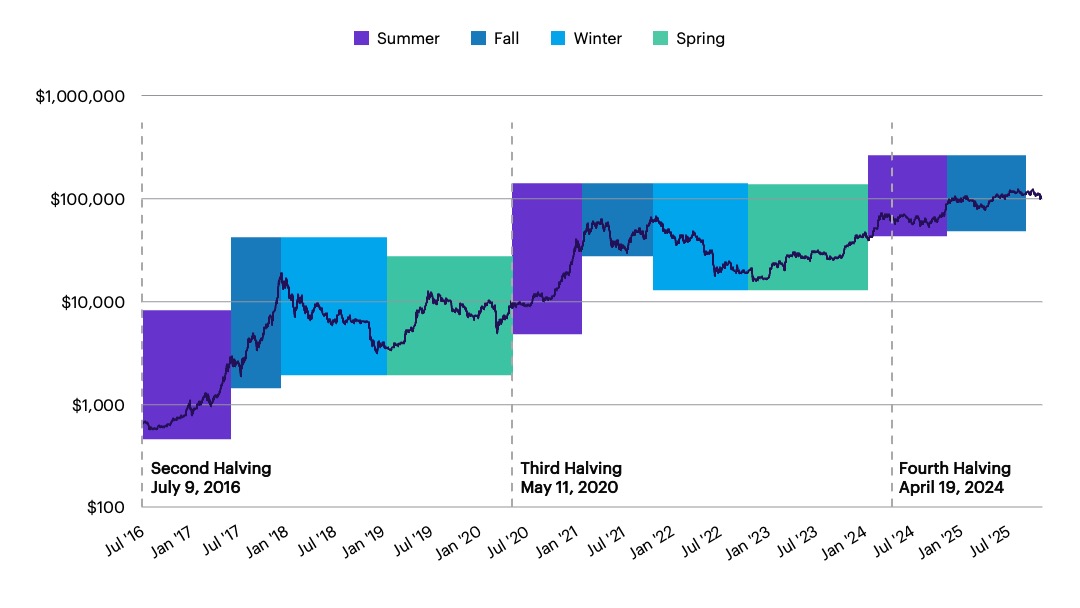Why the four seasons of crypto matter to investors
Morgan Stanley Wealth Management’s Global Investment Office
12/23/25Summary: Is the cryptocurrency bull market nearing an end? The four ‘seasons’ of crypto’s historical trading cycle may hold the answers.

Headlines about cryptocurrency have seemed nearly ubiquitous lately, with enthusiasm frequently soaring. Bitcoin has jumped to record highs and then retreated, only to reach new milestone again—and questions have emerged around when the rally will end. As investors monitor the crypto market, now is a good time to search for insights from past cryptocurrency trading cycles to understand what may lie ahead.
How halving impacts crypto supply
Bitcoin is one of the leading cryptocurrencies and in many ways acts as a proxy for the overall crypto market. One unique thing about bitcoin is that it is designed to go through a process called “halving.” This means that every four years, the number of bitcoins created every 10 minutes is cut in half. The quadrennial halving most recently occurred in April 2025 and will continue until there is a total of 21 million bitcoins in existence. This process was designed to create scarcity so bitcoins maintain their value.
By intentionally limiting the supply of bitcoin, halving can affect the price of bitcoin to spur a bull run. There have been four halvings since bitcoin’s inception in 2011, and each has kicked off a bull run that spanned anywhere from 12 to 18 months.
Exibit 1: Seasonal Crypto Index

Source: Morgan Stanley Wealth Management, GIO, Bloomberg, Coindesk.com. M2 is a measure of the money supply that includes all elements of M1 as well as “near money”. M1 includes cash and checking deposits, while near money refers to savings deposits, money market securities, mutual funds and other time deposits. Drawdown is the peak-to-trough decline during a specific period. Past performance is no guarantee of future results. Estimates of future performance are based on assumptions that may not be realized. This material is not a solicitation of any offer to buy or sell any security or other financial instrument or to participate in any trading strategy. Please refer to important information, disclosures and qualifications at the end of this material.
What are the four seasons of crypto?
The cryptocurrency cycle can be thought of as having four ‘seasons’:
- Summer: Historically, most of bitcoin’s gains come directly after the halving. This “summer” period starts with the halving event and ends once the price of bitcoin hits its prior peak. Historically, this period has lasted about five months, on average.
- Fall: Once the price surpasses the old high, it tends to attract interest from the media, new investors, and businesses, which can then drive prices even higher. The “fall” represents the time between when the old high is passed and a new high is reached, which signals that the bull market has run its course. Under this framework, bitcoin entered “fall” in December 2024. Historically, crypto fall has lasted 10 months, on average, but the current period has already spanned longer than that.
- Winter: The inevitable bear market comes when investors decide to lock in their gains, causing prices to drop while scaring off new investment. This “winter” period takes place between when the new high is reached and the price of bitcoin hits its next bottom. There have been four crypto winters since 2011, each lasting about 13 months, with sharp declines similar in magnitude to that of US equities during the Great Depression.
- Spring: The crypto market tends to recover from its lows in anticipation of the coming summer period as investors try to get in before prices spike with the next bull market. This “spring” period of historical price momentum occurs between the latest bottom and the next halving event, starting the cycle anew. On average, it spans 17 months.
Exhibit 2: Summer Has Historically Resulted in the Highest Bitcoin Returns
Crypto Season |
Season Descriptionn |
Average Duration (Months) |
Average Monthly Return (%) |
|||
2012 Cycle |
2016 Cycle |
2020 Cycle |
All Cycles |
|||
Spring |
Period between the trough and halving |
17 |
7 |
8 |
8 |
7 |
Summer |
Period between the halving and the prior peak |
5 |
41 |
10 |
14 |
17 |
Fall |
Period between the prior peak and the new peak |
10 |
82 |
31 |
12 |
39 |
Winter |
Period between the peak and the trough |
13 |
-9 |
-8 |
-8 |
-8 |
Source: Morgan Stanley Wealth Management GIO, Bloomberg as of April 30, 2024
Past performance is no guarantee of future results. Estimates of future performance are based on assumptions that may not be realized. This material is not a solicitation of any offer to buy or sell any security or other financial instrument or to participate in any trading strategy. Please refer to important information, disclosures and qualifications at the end of this material.
Fall can be a time to harvest
In prior cycles, among the four seasons, crypto fall has seen the highest monthly returns and multiyear peaks, but it has also been the most volatile season and precedes the steepest declines of the cycle. The current fall has lasted longer than previous ones, and a widespread encryption issue or a major software bug could set off a sudden crash that ends the bull run.
Even if the most dire risks don’t materialize, it seems reasonable to harvest gains in the fall and rotate to other assets before crypto winter starts. As North American farmers know well, while waiting an extra week or two in the fall might result in better crop yields, leaving crops in the ground for too long can be disastrous if winter takes hold sooner than expected.
Bottom line
While no one can tell you if now is the right time to buy or sell cryptocurrency, today is the right time to learn more about the crypto market’s cyclical tendencies so that you can ask questions, monitor trends, and determine for yourself whether to invest.
One key thing to keep in mind: As with any investment, past performance doesn’t indicate future results. Potential risks such as encryption breaking, software bugs, recession, or coordinated government action could emerge before the halving and disrupt the cycle.
CRC# 5044706 12/2025
How can E*TRADE from Morgan Stanley help?
Bitcoin Exchange-Traded Products (ETPs)
Spot bitcoin ETPs and futures-based bitcoin exchange-traded funds (ETFs) make it simple to invest in bitcoin without the trouble of owning the cryptocurrency itself.
Cryptocurrency
Cryptocurrencies are not offered directly via E*TRADE, but it is possible to gain indirect exposure to popular cryptocurrencies via securities and futures.